The only reason we drink bottled water now is this: We’re college students.
We don’t have clean cups to drink from.
But thanks to the City of Waco, if we were ever to wash our dishes (not likely), we could drink safe, clean, taste- and smell-free tap water.
This is thanks to several measures by the city of Waco, including the construction of a state-of-the-art Dissolved Air Flotation plant, which went online in 2011, built specifically to help alleviate the odor and unpleasant potting-soil flavor that came to be associated with Waco water, and the Waco Wetlands, a site that not only improves citizens’ water quality, but helps to offset habitat loss in the area.
Once upon a time, Waco tap water had a nasty reputation usually reserved for less developed countries — not meant for human consumption. Although the water has historically been safe to drink, it was still an unpleasant experience.
That reputation has been slow to change, although now it is completely undeserved. Waco tap water is currently no worse than any other city’s municipal water — which is to say, it’s still a sugar-free, fat-free flavorless beverage — the equivalent of any other healthy thing.
Still, a flavorless beverage is much better than one with a bad flavor.
It used to go something like this: During the long, hot Waco summers, chances are you spent some time outside, leaving you sweaty, hot and tired. You just wanted a cool drink of water and some good old air conditioning. But your water tasted like a mud puddle; the ice inside, grass-flavored popsicles.
It wasn’t refreshing, to say the least.
The problem came from geosmin – which is not a sneeze, but a dissolved gas that results from the decomposition of algae from Lake Waco, the source of our water.
The new plant was built to combat these issues; the two plants that treated water in the city before, the Riverside and Mt. Carmel Treatment Plants, did little to remove the algae, although they disinfect and filter water to ensure its safety.
Now, raw water passes through the Dissolved Air Flotation plant first, which uses a chemical to encourage solid particles in the water to attach to air bubbles in the water and float to the top. The particles clump together and form a sludge, which is skimmed off, and the clarified water continues on to one of the two other plants for more disinfection. This process has eliminated the bad taste and smell.
The Lake Waco Wetlands is another way in which the city is making progress in its treatment of natural resources. The man-made wetlands — made possible by the city, the U.S. Army Corps of Engineers, the Texas Department of Parks and Wildlife and Baylor University — also help to filter 11 million gallons of water a day, a fraction of the water processed by the city.
The primary function of the Wetlands is to provide a valuable ecosystem to help offset the habitat loss occasioned by the raising of Lake Waco.
According to a Corps of Engineers report from 2010, the wetlands help to remove phosphorous and nitrogen from the Bosque River, two by products of upstream agriculture related to water quality, before the water flows back into the lake and is treated at the city’s treatment plants.
On the whole, the city of Waco and its partners — including Baylor — have done a stellar job improving the quality of water in Waco.
Any further questions to the quality of Waco’s water should be forgotten in the face of the progress that has been made.
So, if you are a responsible adult-type who washes your own dishes, give the water a try.
If you’re not, that foul taste is all you.
The water’s fine.







